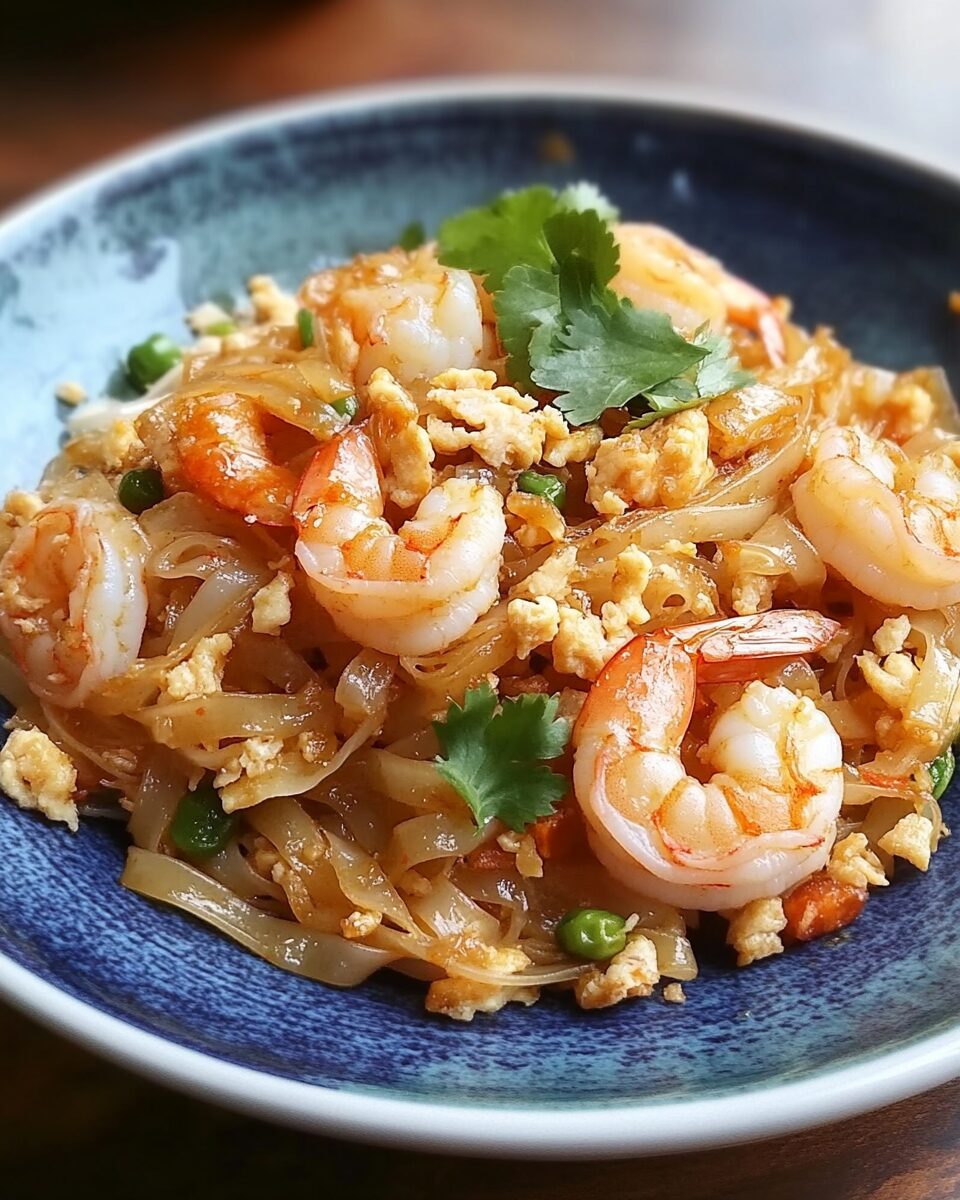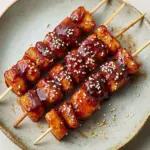The Best Shrimp Pad Thai brings the flavor-packed experience of Thai street food right into your kitchen. With succulent shrimp, crispy tofu, tender noodles, and a savory-sweet tamarind sauce, it’s a colorful stir-fry that’s both bold and comforting. Topped with crushed peanuts and fresh cilantro, each bite delivers a satisfying crunch and a balance of spicy, sweet, sour, and umami.
This dish is perfect for a quick weekday dinner or a weekend cooking adventure. Despite its complex flavor profile, it comes together in just 45 minutes. Whether you’re a Thai food connoisseur or just exploring, this recipe hits the sweet spot between authentic taste and simple preparation. Don’t forget the lime wedges—they bring everything to life!
Full recipe:
Ingredients:
-
5 ounces flat rice stick noodles
-
3 tablespoons fish sauce
-
2 tablespoons brown sugar
-
2 tablespoons tamarind concentrate or tamarind paste
-
1 tablespoon freshly squeezed lime juice (plus more lime wedges for serving)
-
1–3 tablespoons sriracha (adjust to taste)
-
3 tablespoons vegetable oil
-
1/4 cup extra-firm tofu, cubed (1-by-1/2-inch pieces)
-
12 medium shrimp, peeled and deveined (about 5 ounces)
-
1 shallot, thinly sliced
-
1 large egg, lightly beaten
-
1/2 red bell pepper, thinly sliced
-
3 thin scallions, diagonally sliced into 1-inch pieces
-
1 cup mung bean sprouts
-
1/4 cup roasted peanuts, chopped
-
1/4 cup fresh cilantro leaves
Directions:
-
Cook noodles according to package directions. Drain and set aside.
-
In a small bowl, combine fish sauce, brown sugar, tamarind concentrate, lime juice, and sriracha. Set aside.
-
Heat vegetable oil in a large nonstick skillet over medium heat. Add tofu and cook until lightly browned, about 4–5 minutes.
-
Push tofu to the side. Add shrimp and shallots; cook until shrimp are opaque, about 3–4 minutes.
-
Push shrimp aside and add the beaten egg to the center. Cook, stirring and breaking it up, about 30 seconds.
-
Add bell pepper and sauté until just softened, about 2 minutes.
-
Add cooked noodles, scallions, mung bean sprouts, and the sauce mixture. Toss everything together with tofu, shrimp, and egg to coat in sauce. Cook 3–5 minutes until sauce thickens slightly.
-
Serve immediately, topped with peanuts, cilantro, and lime wedges.
Prep Time: 15 minutes | Cooking Time: 30 minutes | Total Time: 45 minutes
Kcal: 510 kcal | Servings: 2 servings
The Origins of Pad Thai
Pad Thai as we know it today is a relatively modern dish, especially considering Thailand’s long and rich culinary history. The creation of Pad Thai was encouraged during the 1930s–40s by the Thai government under Prime Minister Plaek Phibunsongkhram. As part of a broader nationalist campaign to promote Thai identity and reduce reliance on Chinese rice exports, the government introduced this noodle-based recipe to the public.
The dish itself blends Chinese stir-fry techniques with native Thai ingredients, making it a beautiful cultural fusion. While noodles came from Chinese culinary traditions, the flavors—fish sauce, tamarind, lime, chili, and palm sugar—are purely Thai. This blending of traditions allowed Pad Thai to grow into a dish that feels both traditional and unique to Thailand.
Why Shrimp is a Preferred Protein in Pad Thai
While Pad Thai can be made with chicken, tofu, or even beef, shrimp remains one of the most traditional and popular choices. The natural sweetness of shrimp pairs well with the tanginess of tamarind and the heat of sriracha or chili flakes. Shrimp also cooks very quickly, making it perfect for fast stir-fry dishes that need everything to come together in minutes.
Moreover, shrimp adds a seafood element that’s common in coastal Thai cuisine. Its tender texture also contrasts nicely with the chewiness of the noodles and the crunchiness of peanuts and bean sprouts. This combination enhances the dish’s complexity without requiring extravagant techniques.
Flavor Profile and Key Components
What makes Pad Thai so special is its masterful balance of the four main Thai flavor components:
-
Sweet – Typically comes from brown sugar or palm sugar.
-
Sour – Delivered by tamarind paste and lime juice.
-
Salty – Brought in through fish sauce.
-
Spicy – Often from sriracha or crushed red chili.
When these components are combined properly, the resulting flavor profile is multidimensional and incredibly satisfying. The noodles act as a neutral canvas that absorb all these flavors, while the vegetables and toppings bring in contrasting textures and freshness.
The addition of roasted peanuts on top provides a nutty crunch, while the bean sprouts add a refreshing crispness. The egg binds everything together with a slight richness, and the scallions and cilantro brighten up the dish with their herby fragrance.
Cultural Significance and Global Appeal
Pad Thai is more than just a meal—it’s a symbol of Thailand’s ability to adapt, evolve, and thrive. In tourist hotspots like Bangkok and Chiang Mai, you’ll find vendors making Pad Thai on the street with incredible skill and speed, creating gourmet-quality meals in mere minutes. This accessibility and deliciousness have helped Pad Thai become Thailand’s culinary ambassador to the world.
In Western countries, it has become a staple in Thai restaurants and home kitchens alike. The use of ingredients like fish sauce and tamarind—once exotic—have become more familiar and easier to find. People are drawn not only to the flavor of the dish but also to its versatility and healthiness.
Because it can be made gluten-free (with rice noodles and tamari), vegetarian (using tofu and skipping the fish sauce), or even keto-friendly (by substituting noodles), Pad Thai appeals to a broad range of dietary needs.
Tips for Perfecting Shrimp Pad Thai at Home
Although Pad Thai is relatively easy to make, there are a few critical tips that elevate it from good to great:
-
Prep All Ingredients First: This is a quick-cooking stir-fry, so having everything chopped and ready before you turn on the heat is essential.
-
Use High Heat and a Wok: High heat ensures that ingredients cook quickly and retain their individual textures. A wok is ideal for even heat distribution and fast tossing.
-
Don’t Overcook the Noodles: Rice noodles can become mushy if overcooked. Soak or boil them just until tender, then rinse with cold water to stop the cooking process.
-
Cook Proteins Separately: Sautéing shrimp and tofu separately prevents overcrowding and ensures they develop a nice texture before being mixed with the noodles.
-
Tweak the Sauce to Taste: Thai cooking is all about balance. You can adjust the amount of tamarind, sugar, or sriracha to suit your preferred flavor profile.
Nutritional Overview
Shrimp Pad Thai is a relatively balanced dish, especially when made at home. It includes lean protein from shrimp and eggs, healthy fats from peanuts, and complex carbohydrates from rice noodles. It also incorporates a variety of fresh vegetables, making it more nutrient-dense than many other takeout options.
Depending on the exact ingredients and portion sizes, a typical homemade Shrimp Pad Thai serving contains approximately 500–550 calories. It also offers a good dose of vitamin C (from lime juice and bell peppers), iron (from shrimp), and fiber (from bean sprouts and noodles).
However, it can be high in sodium due to fish sauce and tamarind concentrate, so those watching their salt intake may want to use low-sodium alternatives.
Common Variations of Pad Thai
There are countless ways to personalize Pad Thai without losing its essence. Some popular modifications include:
-
Pad Thai Jay (Vegetarian/Vegan): Omits meat and fish sauce, using tofu and soy-based sauce instead.
-
Chicken Pad Thai: Substitutes shrimp with thin slices of chicken breast.
-
Crab or Lobster Pad Thai: Offers a more luxurious seafood experience.
-
Zoodle Pad Thai: Uses spiralized zucchini in place of noodles for a low-carb version.
-
Peanut Butter Pad Thai: Adds creamy peanut butter into the sauce for a richer, nuttier flavor.
These adaptations demonstrate the flexibility of Pad Thai and its capacity to appeal to a wide range of palates and dietary restrictions.
Conclusion
Shrimp Pad Thai is much more than just a stir-fried noodle dish. It embodies the heart of Thai cuisine—its harmony, simplicity, and bold use of flavor. From its humble beginnings as a government-promoted national dish to its current status as a global favorite, Pad Thai’s journey is a testament to the power of food as cultural storytelling.
Its appeal lies not only in its vibrant taste but also in its adaptability. Whether you’re enjoying it from a street vendor in Bangkok or making it in your kitchen halfway around the world, Pad Thai remains a dish that satisfies, delights, and connects people.
So the next time you’re craving something hearty, zesty, and deeply comforting, consider whipping up a batch of Shrimp Pad Thai. It’s not just a meal—it’s an experience of culture, flavor, and culinary craftsmanship that continues to win hearts everywhere.






